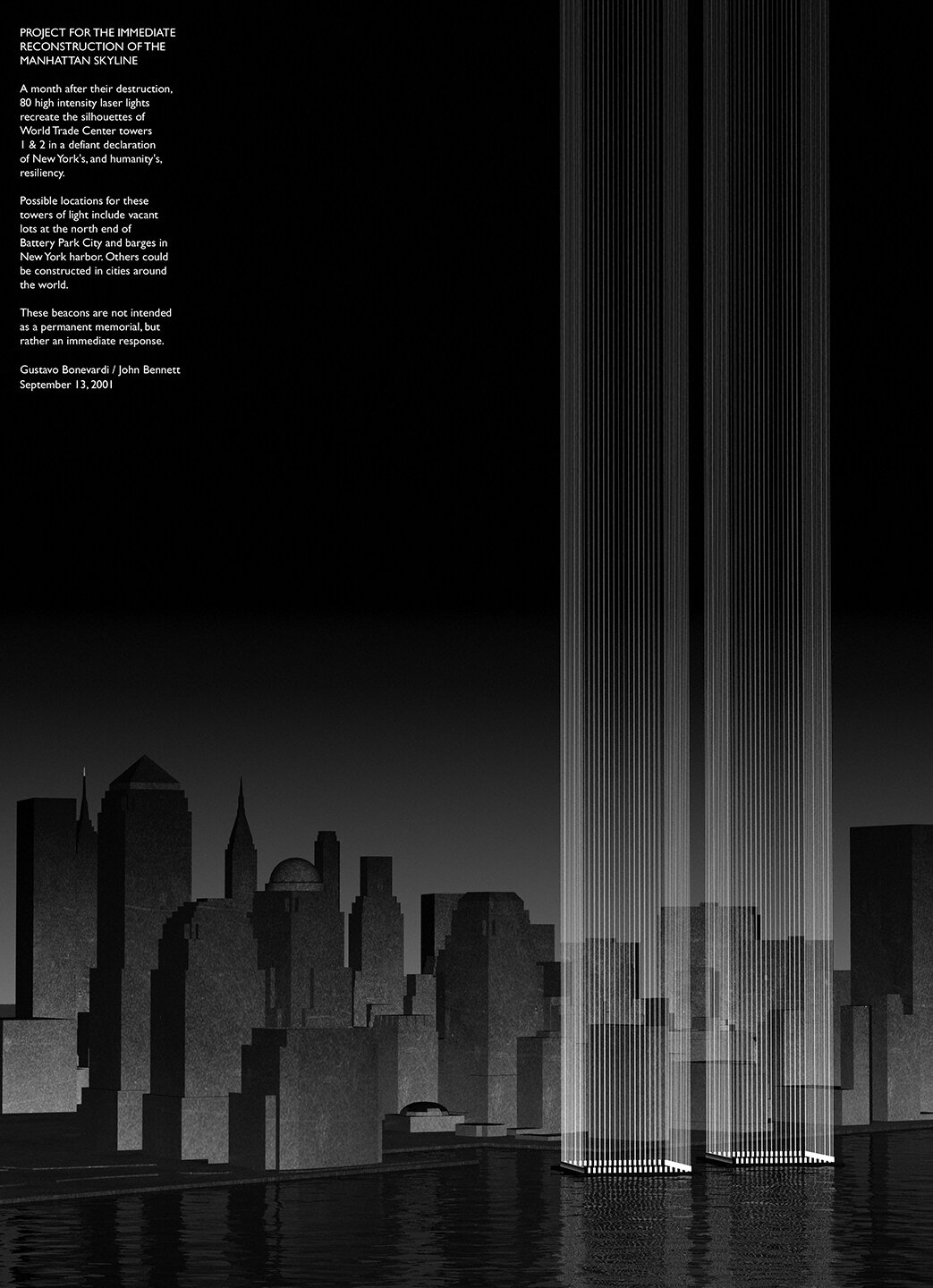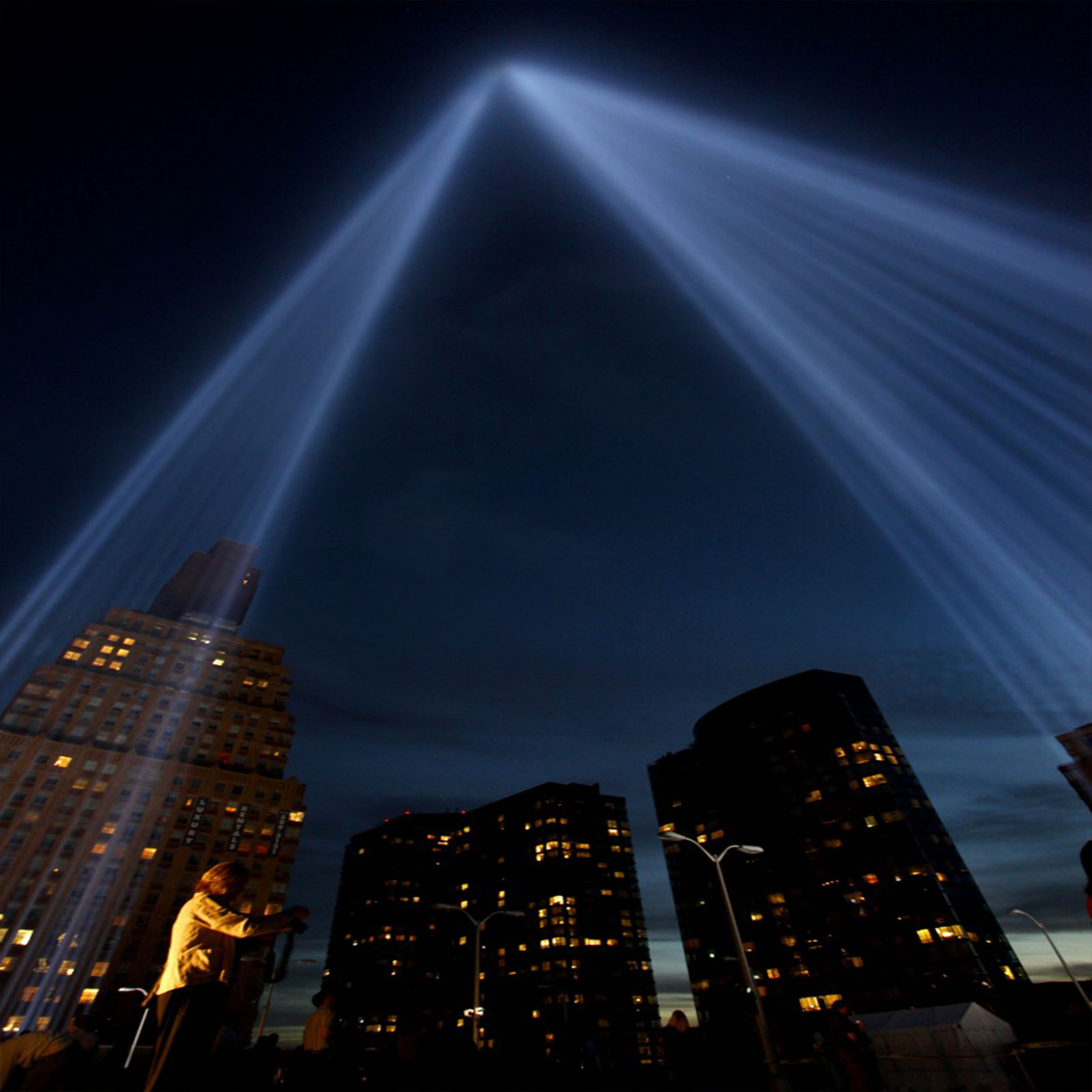TRIBUTE IN LIGHT
A memorial to the lives lost at the World Trade Center which looks to heal the New York City skyline by restoring the image of the Twin Towers in a medium that is ethereal, indestructible, and symbolic of life. (Conceived with John Bennett and realized in collaboration with Bennett, Richard Nash Gould, Julian LaVerdiere, Paul Myoda and Paul Marantz, under the auspices of Creative Time and The Municipal Art Society.)
Produced annually on September 11
New York, NY
88 high-intensity searchlights
Overall installation approximately 125’ x 230’ x ∞
SELECTED PRESS
“Public Spirit, Private Money and a New New Deal”
The New York Times
New York, NY
March 24, 2002
Critical essay by Herbert Muschamp
''Tribute in Light, the temporary memorial to the victims of the World Trade Center attack, appeals to the powerful desire to undo wrongs. As conceived back in September by John Bennett and Gustavo Bonevardi, two of the designers responsible for the project, the work was initially called Proposal for the Immediate Reconstruction of the Manhattan Skyline, as if by filling in the twin voids with brightness we could blot out the galling sensation of being overtaken by events outside our control.”
“Towers of Light”
The New Yorker
New York, NY
October 1, 2001
News story by Calvin Tomkins
ARTIST STATMENT
(A version of this essay appeared in Slate, the online magazine, on March 11, 2002)
The morning of September 11th thrust me back into childhood. I don’t mean that it brought back a flood of memories. (Though it did: I grew up in the Meat Packing District, just north of Lower Manhattan, where I still live and work, and the construction of the towers was a backdrop to my childhood.) I mean that I was seeing the world again as a child. My grown-up frame of reference suddenly felt useless; the work and life I had literally and figuratively built felt irrelevant. After watching the buildings crumble, all I could think of was that I wanted everything back the way it had been. That night, I biked around aimlessly, eventually making my way downtown. The skyline was all wrong, but also strangely familiar, like an echo from a time before the towers existed. I took some pictures.
Like everyone else, John Bennett, my creative partner, and I wanted to do something to help, and previous experiences had taught us that it was possible, through architecture, to respond to a need and make a difference. Sometime that night, as my brain kept insisting on its childish demand to have the towers back, we hit on a way it could be done.
The next morning, drawing on our experience in architecture and computer modeling, we developed the idea into a viable proposal and made a digital rendering. We circulated it widely, along with a short statement:
PROJECT FOR THE IMMEDIATE RECONSTRUCTION OF THE MANHATTAN SKYLINE
A month after their destruction, 80 high intensity laser lights recreate the silhouettes of World Trade Center towers 1 & 2 in a defiant declaration of New York’s, and humanity’s, resiliency. Possible locations for these towers of light include vacant lots at the north end of Battery Park City and barges in New York harbor. Others could be constructed in cities around the world. These beacons are not intended as a permanent memorial, but rather an immediate response.
John and I imagined the lights not as a representation of the buildings but rather of their absence, like an after-image frozen in time. But they were not going to be a memorial or an expression of sorrow. (For one thing, there was still hope, in those first days, that more survivors would be rescued.) Instead, we thought of the project as a kind of temporary repair or rebuilding of the city and a defiant assertion of presence, perseverance and hope. The towers, in anchoring Manhattan’s skyline, had shaped the city’s identity, and now with the skyline ripped open, that identity felt ripped open, too, put into question. We imagined a monument that would fill the void, in a medium that symbolizes life. And we wanted it there as quickly as possible, to inspire the rescue workers and the city at large, and to show the world that New York was still New York.
The essence of our proposal was that it be immediately achievable, so unlike ideas that emerged later, we never entertained the idea of having columns of light rise directly from the still- burning ruins of the towers. We proposed instead that the lights be installed at one of several sites in the vicinity of Ground Zero, including the vacant lots immediately to the nor th where they were ultimately placed. (Similarly, as the project went forward, we didn’t worry about replicating the huge footprints of the towers, but focused instead on recreating the gap between them, which defined their relationship to each other.) The reconstruction of the skyline did not have to be literal, it just had to be done, and the sooner the better.
The hunger for such a response was obvious in the immediate reactions we got. Enthusiastic emails poured in, including from people we hoped might be able to help our effort to realize the project, like the New York Times architecture critic, Herbert Muschamp, and the Museum of Modern Art’s chief design curator, Terence Riley. A few days later the New York Post published an article about our project, introducing the idea of a “monument of light” to the wider public.
As it turned out, we were not the only ones to envision the absent buildings as towers of light. Days after the Post ar ticle, for example, the Times published images of a similar notion that the artist team of Julian LaVerdiere and Paul Myoda rendered in response to a commission from the paper. As our project moved forward, we came to collaborate with them, along with an architect, Richard Nash Gould. I think the reason why we all, and others, had the same impulse was that we had all been staring at the towers for so many hours that day, and the image was practically burned into our retinas.
The five of us and Paul Marantz, a lighting designer, came together under the aegis of the public art organization Creative Time and The Municipal Ar t Society, which would eventually procure funding, consult with the families of victims, and coordinate with the mayor’s office and various city, state and federal agencies. John and I used computer modeling to visualize and evaluate potential sites and developed the plans with Paul Marantz and Micheal Ahern, a production designer, who together went on to take the lead in making the project a reality.
Our hopes of realizing the project in a month went unfulfilled, but on March 11, 2002, only six months after the attacks, the tribute was illuminated. Given the state of things in Lower Manhattan and the complexity of New York’s bureaucracies even in the best of times, the remarkable speed with which it was done is a testament to the cooperation and goodwill in the city at the time, as well as the dogged hard work of everyone, especially The Municipal Ar t Society.
Already by the time of that first illumination it was clear that the tribute’s meanings had shifted and expanded. It still expressed humanity’s brighter side and offered a kind of renewal through assertion. But it had also become a memorial. Perhaps it always had been, and it was just too much to accept, until then, that that was what we were creating.
G.M.B.











